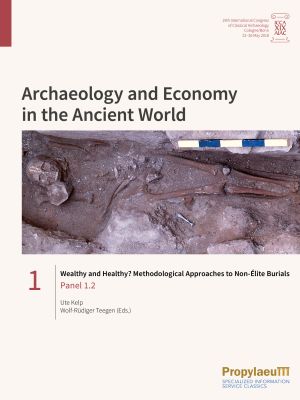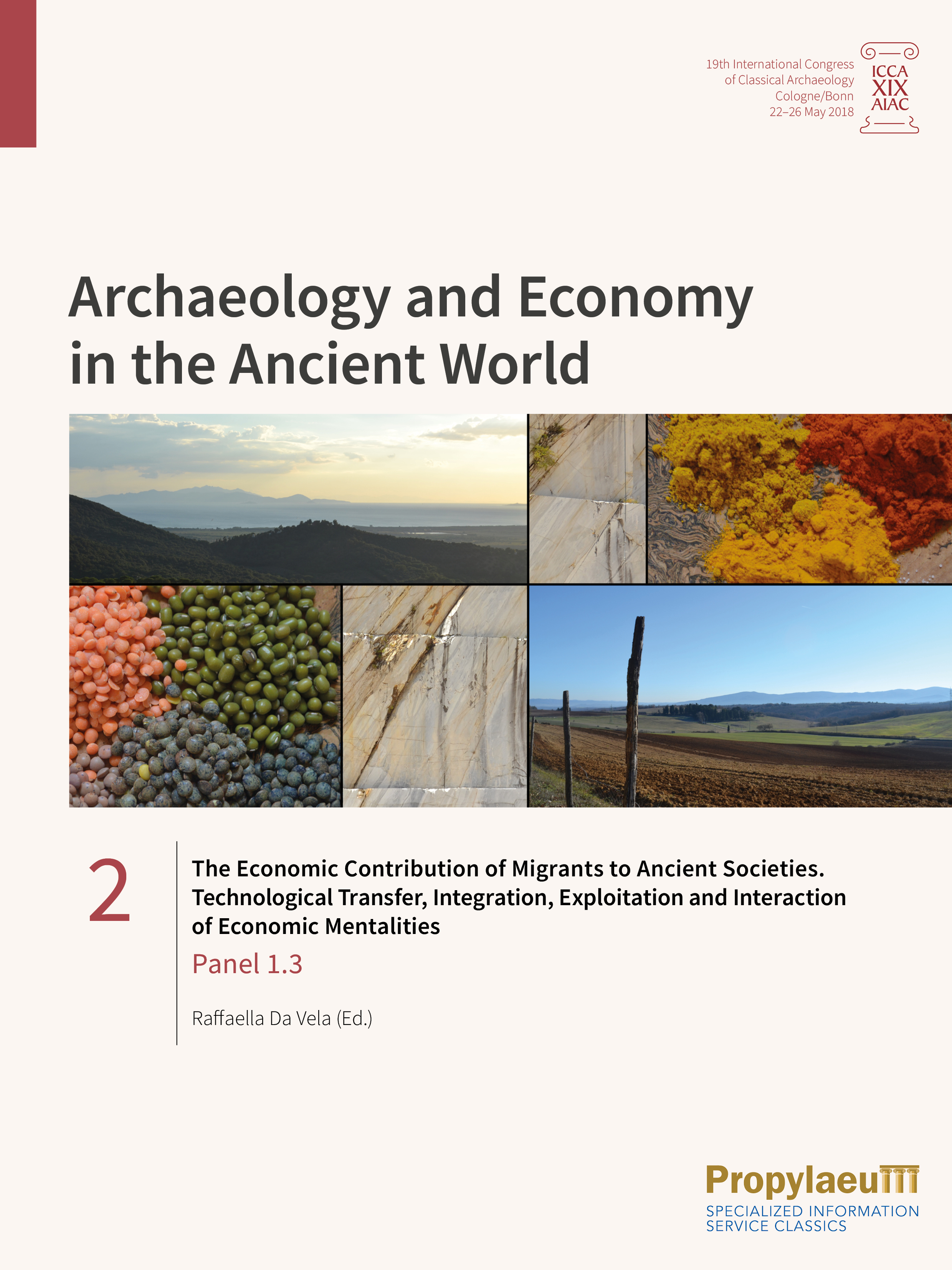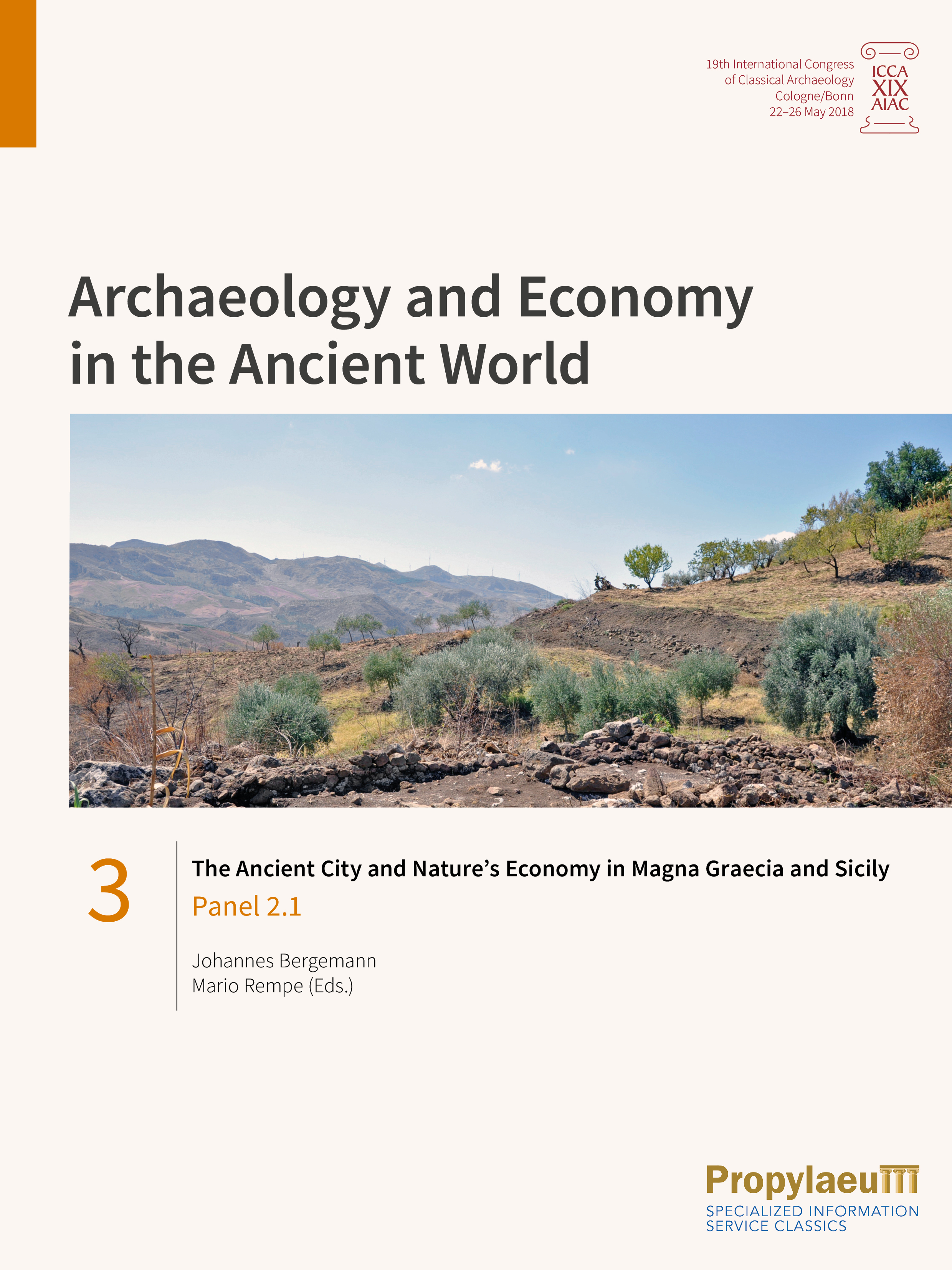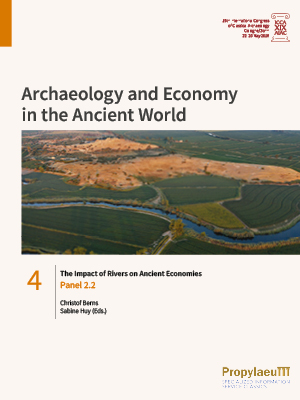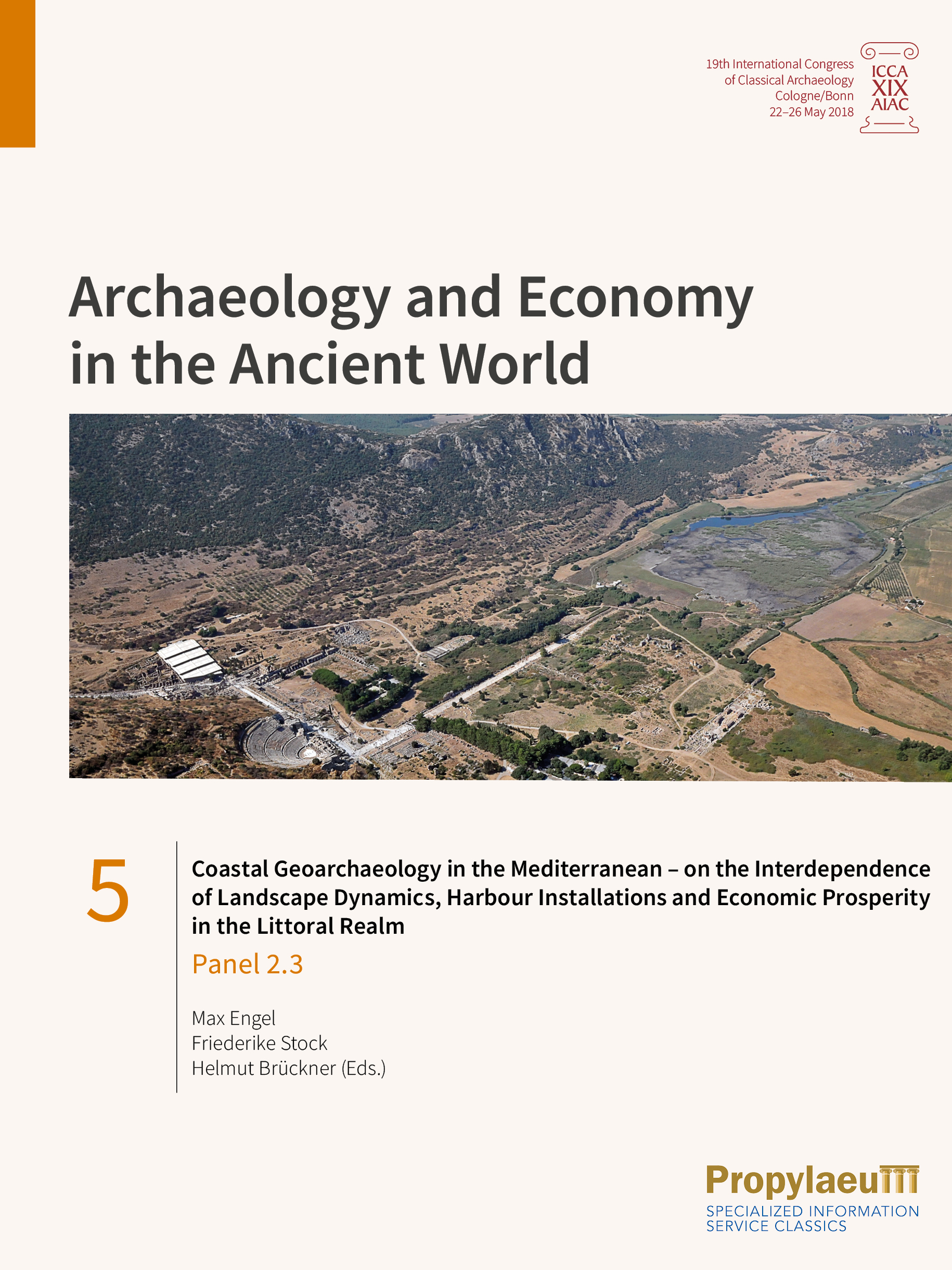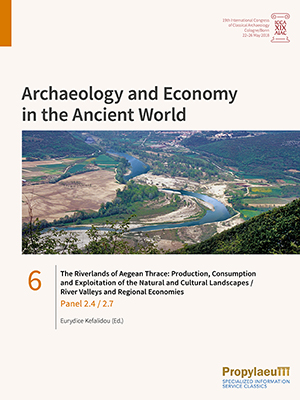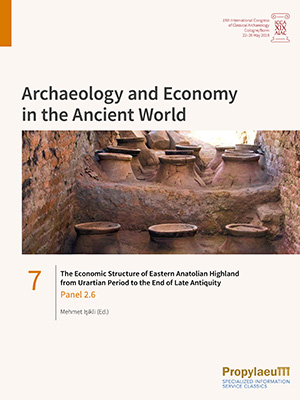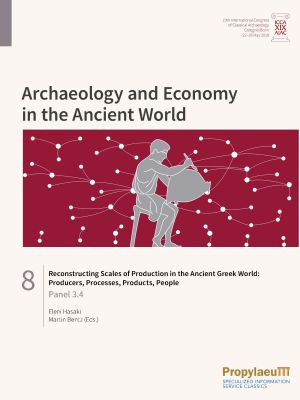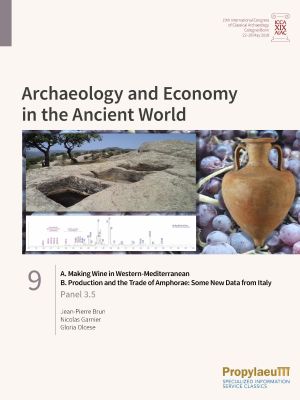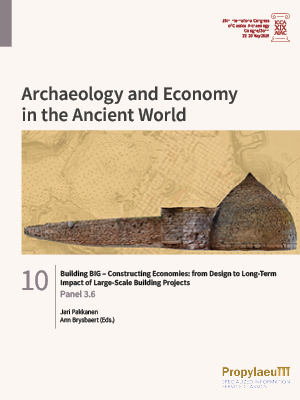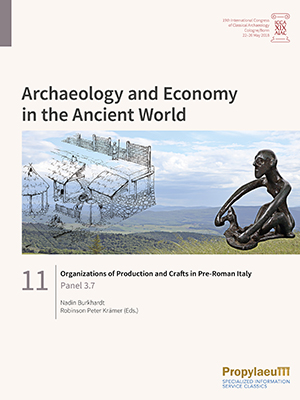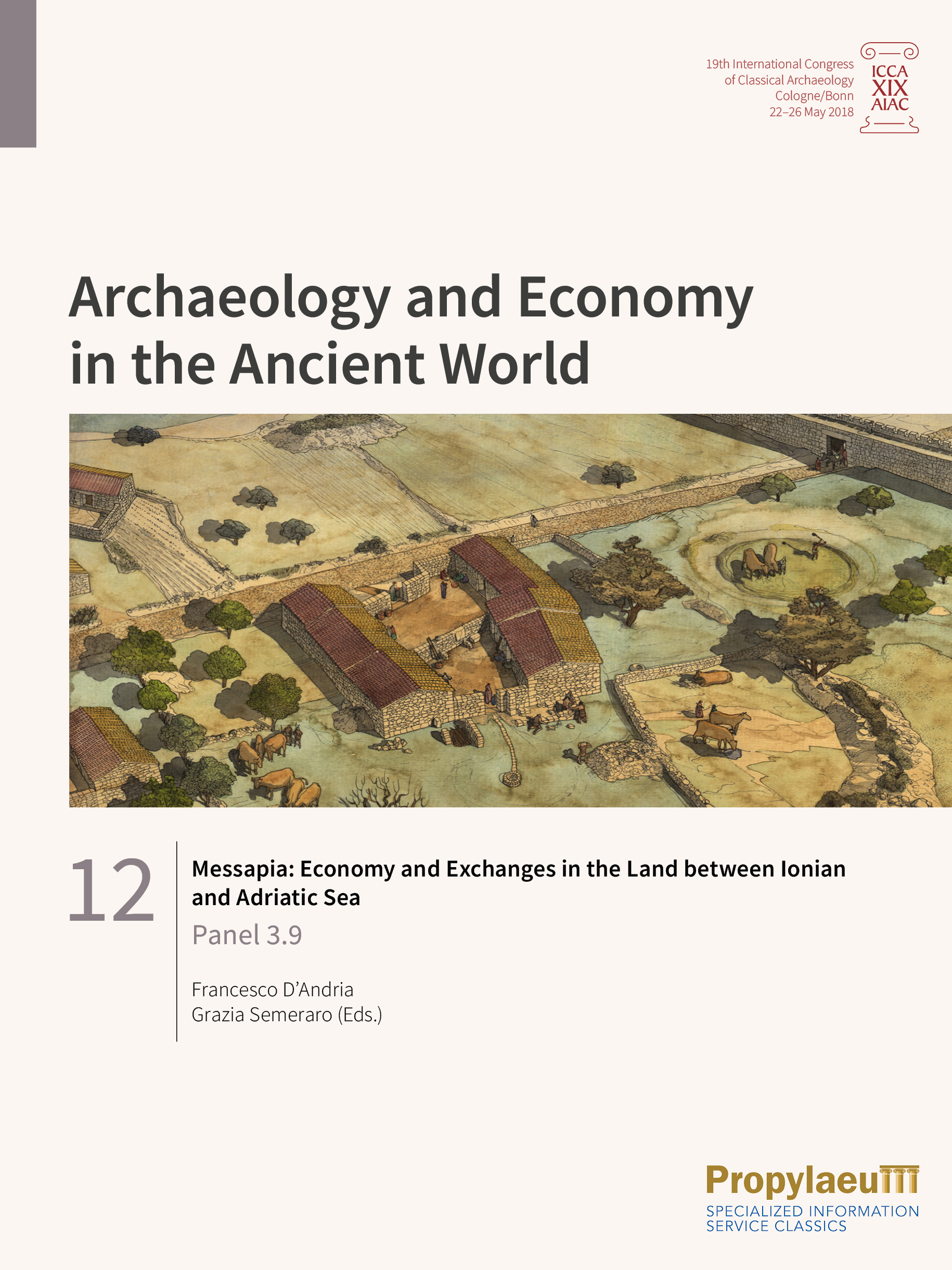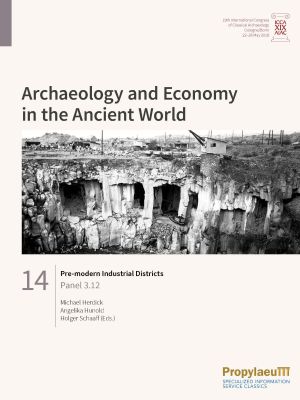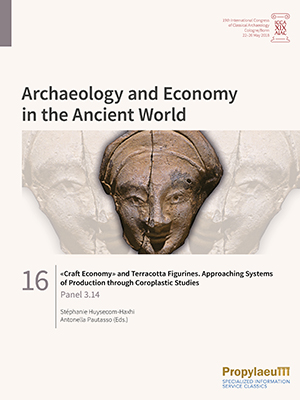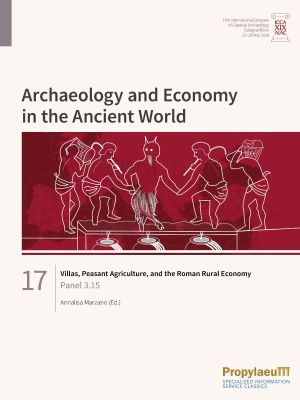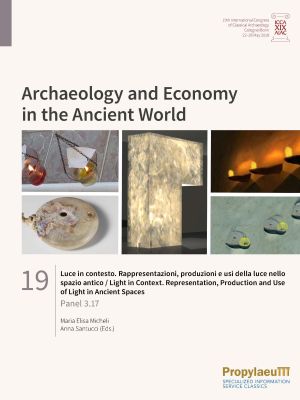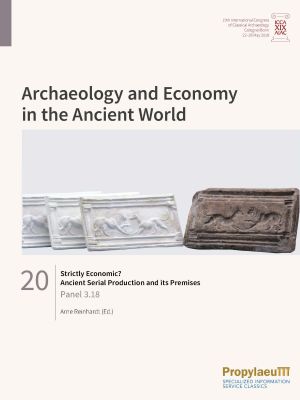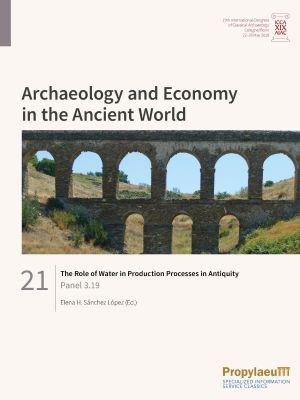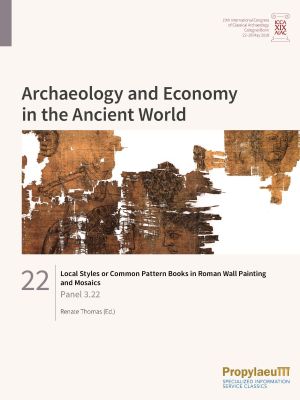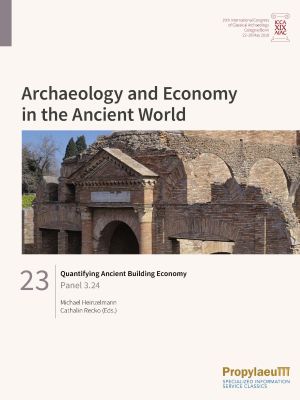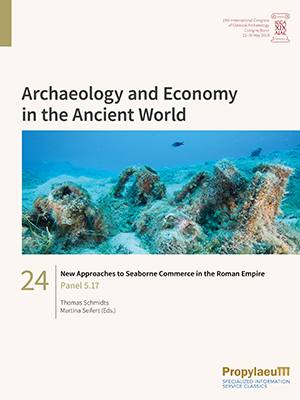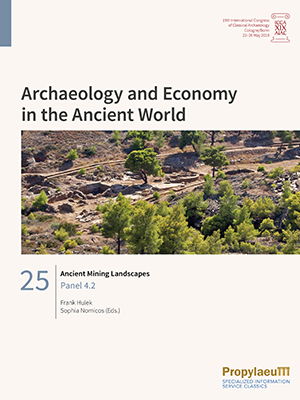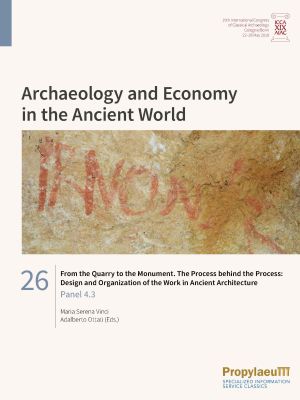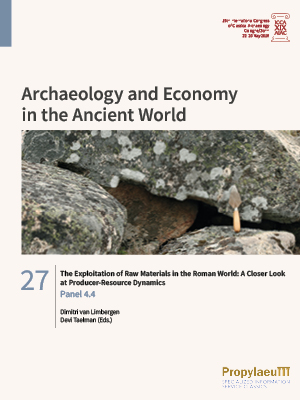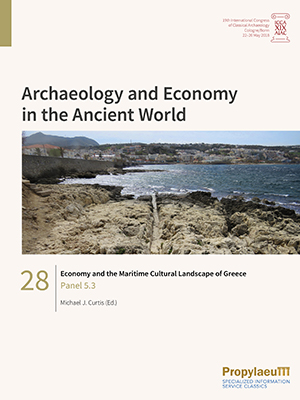Archaeology and Economy in the Ancient World
Proceedings of the 19th International Congress of Classical Archaeology, Cologne/Bonn 2018
Die vorliegenden Bände bilden die Abschlusspublikation des 19. Internationalen Kongresses für Klassische Archäologie, der vom 22. bis 26. Mai 2018 unter der Ägide der ‘Associazione Internazionale di Archaeologica Classica (AIAC)’ in Köln und Bonn abgehalten wurde. Unter dem Titel ‘Archaeology and Economy in the Ancient World’ beschäftigten sich mehr als 900 Einzelvorträge, gegliedert in 11 Sektionen und 128 Panels mit unterschiedlichsten Fragen zur antiken Wirtschaftsgeschichte.
Tatsächlich durchdringen wirtschaftliche Aspekte alle Bereiche des öffentlichen und privaten Lebens in alten Gesellschaften, sei es in der Stadtentwicklung, der Religion, der Kunst, dem Wohnen oder dem Tod. Die Erforschung der antiken Wirtschaft spielt seit langem eine wichtige Rolle in der Alten Geschichte. In den letzten Jahrzehnten ist aber auch in der Archäologie zunehmend das Bewusstsein gewachsen, dass die materielle Kultur alter Gesellschaften ausgezeichnete Möglichkeiten bietet, die Struktur, Leistung und Dynamik alter Wirtschaftssysteme und Wirtschaftsprozesse zu untersuchen. Hauptziel dieses Kongresses war es daher, die Ökonomie als ein zentrales Element der klassischen Gesellschaften zu verstehen und ihre Wechselwirkung mit ökologischen, politischen, sozialen, religiösen und kulturellen Hintergründen zu analysieren. Das Thema des Kongresses richtete sich an alle Disziplinen, die sich mit der griechisch-römischen Zivilisation und ihren Nachbarkulturen von der ägäischen Bronzezeit bis zum Ende der Spätantike befassen.
In der vorliegenden Reihe sind zahlreiche Panels als eigenständige Themenbände vorgelegt (Band 1–52). Die übrigen Beiträge wiederum sind in vier Sammelbänden zusammengestellt (Band 53–56).
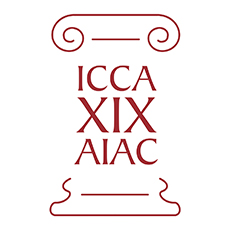
Herausgeber
Prof. Dr. Martin Bentz
Institut für Archäologie und Kulturanthropologie
Universität Bonn
Prof. Dr. Michael Heinzelmann
Archäologisches Institut
Universität zu Köln
Internet: 19. ICCA 2018
E-Mail: congress.aiac2018@uni-bonn.de
Bisher erschienen
Wealthy and Healthy? Methodological Approaches to Non-Élite Burials: Panel 1.2
Die Analyse antiker Gesellschaften jenseits politischer Systeme, Hauptakteure und Eliten ist in hohem Maße auf archäologische Hinterlassenschaften angewiesen. Zahlreich erhalten sind Gräber und Grabdenkmäler, die als Primärzeugnisse eine aussagekräftige antike Quellengattung darstellen. Allerdings können Nekropolen und Bestattungen weder als Spiegel sozialer Verhältnisse gewertet werden, noch ist eine dichotomische Darstellung der Gesellschaft als Gegensatz zwischen reichen Eliten und einer Masse von mehr oder weniger Armen angemessen. Stattdessen ist eine Kombination verschiedener Kriterien für eine weiterführende Gräberanalyse notwendig. Insbesondere menschliche Skelette sind erstklassige bio-historische Quellen, denn Wohlstand und Gesundheit stehen auch in der Antike in unmittelbarem Zusammenhang und menschliche Überreste verraten anhand der Untersuchung von Ernährung und Gesundheit viel über den Status der Verstorbenen.
Die Beiträge in diesem Band thematisieren das Verhältnis zwischen materieller Kultur, Gesundheit und gesellschaftlichem Status, wobei in der Funeralarchäologie verschiedene methodische Ansätze aus den archäologisch-historischen Wissenschaften sowie den Sozial- und Naturwissenschaften zur Anwendung kommen. Die Gräber nicht zur Elite zählender Bevölkerungsgruppen werden zum einen mit Blick auf das soziale Gefüge und den Lebensstil der Verstorbenen erforscht, zum anderen hinsichtlich der Vorstellungen und Ideologien der Hinterbliebenen, die im Bestattungsvorgang und durch die Praktiken am Grab zum Ausdruck kommen. Der Band vereinigt eine Reihe von Fallstudien, die als Kontextanalysen deutlich über den Grabbereich hinausweisen.
The The Economic Contribution of Migrants to Ancient Societies. Technological Transfer, Integration, Exploitation and Interaction of Economic Mentalities: Panel 1.3
Archäologische Studien zu Migranten konzentrieren sich in der Regel auf ihre Rolle in Produktionsaktivitäten, entweder als Teil der Erwerbsbevölkerung oder als spezialisierte Handwerker, die von lokalen Unternehmern, Familien oder öffentlichen Institutionen abhängig sind. Dieses Buch zielt darauf ab, diesen einseitigen Diskurs über die Abhängigkeit von Migranten zu überwinden und einen alternativen Ansatz vorzuschlagen, indem es Migranten als Akteure im Wirtschaftsleben antiker Gesellschaften untersucht. Die wirtschaftliche Dimension der Migration wird somit als Teil der komplexen Dynamik von Integration und Segregation in lokalen Gemeinschaften analysiert. Migranten werden als Konsumenten, Kulturvermittler, soziale Aufsteiger, Vermittler anderer Lebensstile und als "Auslöser" für Innovationen betrachtet. Die Beiträge in diesem Band schlagen neue Methoden und Interpretationswege vor und behandeln ein breites Spektrum von Fallstudien vom mittleren Reich Ägyptens bis zur Bronze- und Eisenzeit des westlichen Mittelmeerraums, vom klassischen Griechenland bis zum hellenistischen Etrurien und schließen mit der Przeworsker Kultur Pannoniens. Unter Überwindung der binären Gegensätze, die gewöhnlich zwischen Kolonisten und indigenen Völkern, Einheimischen und ‘Eingeschmeckten’ aufgebaut werden, zeigt dieses Buch auf, wie wirtschaftliche Mentalitäten Teil einer größeren Verstrickung persönlicher, sozialer und wirtschaftlicher Identitäten sind.
The Ancient City and Nature's Economy in Magna Graecia and Sicily: Panel 2.1
Im Rahmen der Veranstaltung wurden archäologische Landschaftsstudien und paläoökologische Rekonstruktionen vorgestellt und auf diese Weise die Wechselwirkungen zwischen Mensch und Umwelt beleuchtet. Die Verbindung von Archäologie und Geowissenschaften machte an mehreren Orten in Magna Graecia und Sizilien verschiedene Muster dieser Wechselwirkungen sichtbar.
Die Ansätze kombinierten archäologische Methoden mit Geoarchäologie, Palynologie, Archäozoologie und Klimageschichte. Die Fallstudien erstreckten sich über einen langen Zeitraum und reichten bis in die frühen Phasen der griechischen Besiedlung Siziliens zurück. Darüber hinaus wurden Verschiebungen in der Siedlungsdynamik zwischen römischer und griechischer Zeit beobachtet und Hypothesen aus einer paläoökologischen Perspektive aufgestellt. Gleichzeitig wurden die wirtschaftlichen und sozialen Implikationen und ihre Auswirkungen auf die Daten untersucht. Die Beispiele stammten sowohl aus der Surveyarchäologie als auch aus bei Ausgrabungen gewonnenen Proben.
The Impact of Rivers on Ancient Economies: Panel 2.2
Das gewachsene Forschungsinteresse an den Verflechtungen von soziokulturellen und physischen Räumen hat u. a. dazu geführt, Wasserläufe als gestaltende Faktoren von Gesellschaften und ihren Wirtschaftssystemen wahrzunehmen. Flusslandschaften weisen spezifische Bedingungen auf, die das Leben von Menschen vielfach beeinflusst haben. Flüsse bieten als natürliche Ressourcen besondere Möglichkeiten für wirtschaftliche Aktivitäten. Sie können beispielsweise sowohl als Verbindungsadern als auch als Grenzlinien fungieren. Die Beiträge unseres Panels beschreiben Flüsse als dynamische Faktoren antiker Lebenswelten. Die Aufsätze dieses Bandes konzentrieren sich auf die Wechselbeziehung zwischen Flusslandschaften und den wirtschaftlichen Gewohnheiten ihrer Bewohner. Die Fallstudien decken ein breites zeitliches wie geographisches Spektrum ab und diskutieren Phänomene wie geomorphe und anthropogene Veränderungen von Flüssen, die Rolle von Flüssen als Transport- und Handelswege und ihre Auswirkungen auf Siedlungsmuster.
Coastal Geoarchaeology in the Mediterranean – on the Interdependence of Landscape Dynamics, Harbour Installations and Economic Prosperity in the Littoral Realm: Panel 2.3
Die Küsten des Mittelmeers sind hochdynamische Landschaftbereiche, die sich innerhalb der vergangenen etwa sechs Jahrtausende im Fall progradierender Deltaebenen um bis zu mehrere Zehner Kilometer lateral verschoben haben. Dieser Prozess führte zur Gefährdung zahlreicher antiker Hafenanlagen und schließlich auch zu deren Trennung von der Küste, was schwerwiegende politische und ökonomische Folgen für die städtischen Zentren und ihr Hinterland mit sich brachte. Gleichzeitig führte der Anstieg des relativen Meeresspiegels stellenweise zur Versalzung von Grundwasserleitern und demnach zu nachteiligen Auswirkungen auf die landwirtschaftliche Produktion. Diese Sammlung an Beiträgen des Panel 2.3 „Coastal geoarchaeology in the Mediterranean – on the interdependence of landscape dynamics, harbour installations and economic prosperity in the littoral realm“ behandelt diese Themen für verschiedene B+ereiche des Mittelmeerraums in den letzten 2500 Jahren. Die dargestellten Studien zeigen erfolgreich, wie geowissenschaftliche Daten entweder zur Lokalisierung von Häfen beitragen oder wie sie die Interpretation archäologischer Überreste und Literaturquellen antiker Autoren maßgeblich unterstützen. Jeder Beitrag ist insofern ein eindrucksvolles Beispiel für die Relevanz interdisziplinärer Ansätze in der Archäologie, wie sie im Konzept der Geoarchäologie zusammengefasst sind.
The Riverlands of Aegean Thrace: Production, Consumption and Exploitation of the Natural and Cultural Landscapes | River Valleys and Regional Economies: Panel 2.4 | Panel 2.7
Flüsse waren schon immer eine wichtige Stütze für die Wirtschaft. Sie versorgten Menschen und Tiere mit Wasser, bewässerten das Land, erleichterten Kommunikation und Handel durch kleine Schiffe oder Flöße, unterstützten industrielle Aktivitäten, bildeten reiche Jagdgründe für Fischer und Jäger und boten Rohstoffe wie Sand, Kies und Placer-vorkommen von kostbaren Metallen - darunter sogar Gold. Gleichzeitig schufen die Flussdeltas und Sumpfgebiete der Flüsse eine unwirtliche Umgebung, die für eine Besiedlung ungeeignet war, insbesondere in Zeiten von Überschwemmungen. Darüber hinaus verbanden Flüsse das Meer und die Küstenzone mit dem Hinterland und ermöglichten so die Interaktion zwischen den Bevölkerungen, die diese Gebiete bewohnten, oft Einheimische und Kolonisten/Händler.
Die Panels 2.4 und 2.7 befassen sich mit den vielfältigen Facetten einiger Flusslandschaften im mittleren und östlichen Mittelmeerraum. Panel 2.4 untersucht das ägäische Thrakien, d.h. den nordöstlichen Teil Griechenlands und den europäischen Teil der Türkei. Panel 2.7 befasst sich mit drei Flusstälern in zwei verschiedenen Gebieten: Athen und Attika mit dem Fluss Ilissos; und Nordostitalien mit den Flüssen, die in den Gebieten von Verona und Parma fließen.
Die Beiträge befassen sich mit Themen wie der Neugestaltung der antiken Flussrouten, den Siedlungs- und Nutzungsmustern, die sich um sie herum bildeten, den Grenzen der Chora verschiedener Städte, Ortschaften, Dörfer und Gehöfte sowie der Kommunikation oder den Spannungen zwischen verschiedenen Gruppen, die sich aus ökologischen und/oder wirtschaftlichen Gründen über ihr ursprüngliches Siedlungsgebiet hinaus ausdehnten oder es verließen.
The Economic Structure of Eastern Anatolian Highland from Urartian Period to the End of Late Antiquity: Panel 2.6
Das ostanatolische Hochland war aufgrund seiner sehr spezifischen Lage eine der herausragenden Subregionen des alten Nahen Ostens. Diese Region mit ihren schwierigen geographischen und klimatischen Bedingungen liegt zentral zwischen Nordmesopotamien, dem Südkaukasus, dem nordwestlichen Iran und Zentralanatolien, die alle wichtige Kulturregionen des Nahen Ostens waren. Das ostanatolische Hochland hat eine wichtige Rolle in den wirtschaftlichen Netzwerken und kulturellen Beziehungen gespielt, die sich im Laufe der Zeit zwischen den südlichen und nördlichen Regionen entwickelten. Trotz seiner schwierigen Geographie und der eher ungünstigen klimatischen Bedingungen war diese Region aufgrund ihrer strategischen Lage und ihres Reichtums an natürlichen Ressourcen und Rohstoffen im Laufe der Zeit die Heimat viele Kulturen und Gesellschaften. Die archäologischen Funde zeigen, dass die anfänglichen Perioden der Zentralisierung und Staatsbildung in der Region mit Urartu begannen und sich im Laufe der Zeit fortsetzten. Der bedeutendste Beitrag hierzu war die Tatsache, dass das Hochland aufgrund seiner strategischen geographischen Lage als Transitregion fungierte. Danach lassen sich die wirtschaftlichen und politischen Strukturen in dieser Bergregion des Nahen Ostens leichter beobachten. Die wirtschaftlichen Strukturen dieser Randzone des antiken Vorderen Orients werden in dieser Session von der Urartu-Zeit bis zum Ende der Spätantike analysiert.
Reconstructing Scales of Production in the Ancient Greek World: Producers, Processes, Products, People: Panel 3.4
Forscher haben unterschiedliche, sowohl traditionelle als auch experimentelle Ansätze verfolgt, um den Umfang handwerklicher Produktion zu bestimmen, eine wichtige Grundlage für Aussagen zur antiken Wirtschaft. In diesem Panel werden neue Berechnungsmethoden vorgestellt: zur Größe von Werkstätten und ihrer Belegschaft, zum Zeitaufwand für den gesamten Herstellungsprozess von Produkten, zur Bedarfsmenge bzw. zur Nachfrage der Bevölkerung nach bestimmten Produkten sowie zum heute erhaltenen Anteil antiker Produktionsmengen. Methoden, die teilweise von benachbarten Disziplinen entwickelt wurden, helfen, das archäologische Material neu zu interpretieren. Durch Anwendung der sozialen Netzwerkanalyse und durch Berechnungen der Arbeitsleistung einzelner Handwerker, der Bauwirtschaft und des Verhältnisses von Produktions- und Konsumptionsmengen soll ein besseres Verständnis der Leistungsfähigkeit und des Umfangs des Handwerks in Griechenland und in den griechischen Kolonien geschaffen werden. Archäologen und Wirtschaftshistoriker nutzen hierbei, vor allem auf der Mikro-Ebene, Variablen wie die Rohstoffbeschaffung, den Einsatz von Arbeitskraft, gegenseitige Abhängigkeiten verschiedener Handwerke, Ausbildungszeiten und Nachfragezahlen. Chronologisch reicht der Rahmen von der Prähistorie bis in die klassische Zeit, geographisch liegt der Fokus auf Griechenland und Italien, thematisch auf Keramik, aber auch auf Fußbodenbelägen sowie Grabarchitektur.
A. Making Wine in Western-Mediterranean B. Production and the Trade of Amphorae: Some New Data from Italy: Panel 3.5
Ziel dieses Bandes ist es, mit Hilfe von Archäologie, Archäometrie, Archäobotanik und Molekulararchäologie neue Daten und aktuelle multidisziplinäre Projekte zum Weinbau in der Antike vorzustellen; und zwar sowohl zur Weinherstellung und -verbreitung als auch zu den Behältern, in denen der Wein aufbewahrt wurde.
Die Studien in diesem Band konzentrieren sich auf Italien und seine Beziehungen zu anderen Gebieten (Spanien, Malta), um unsere Kenntnisse über die Veränderungen in der Agrarlandschaft zu vertiefen. Ein weiterer Schwerpunkt sind Weinproduktionsanlagen, die bisher noch wenig erforscht sind, wie z.B. in den Fels eingearbeitete Behälter.
Die fortschreitende Entwicklung technischer Analysemöglichkeiten ermöglicht nach und nach die Beantwortung der alte Frage der Unterscheidung zwischen Produktionsanlagen für Wein und Olivenöl. Es war bekannt, dass für beide Produkte die gleichen Pressen verwendet werden, aber jetzt können durch die systematische Flotationsanalyse Olivenkerne oder Traubenkerne zum Vorschein kommen, und biochemische Analysen in der Gaschromatographie oder Flüssigkeitschromatographie in Verbindung mit der Massenspektrometrie liefern heute sehr zuverlässige Ergebnisse über die Rückstände in den Fässern.
Im zweiten Teil des Bandes werden einige neue archäologische und archäometrische Daten zur Herstellung und Verbreitung von Weinamphoren - die von der tyrrhenischen Küste Italiens, Spaniens und Afrikas stammen - in Italien und im westlichen Mittelmeerraum vorgestellt, deren Untersuchung ebenfalls mit Labormethoden durchgeführt wurde.
Building BIG – Constructing Economies: from Design to Long-Term Impact of Large-Scale Building Projects: Panel 3.6
Dieser Band enthält verschiedene Studien, die von prähistorischen griechischen Bauprogrammen bis zum Bauen in der römischen Zeit reichen. Das Wirtschaftswachstum moderner Gesellschaften ist eng mit der Bauwirtschaft verknüpft: Investitionen, Transportinfrastrukturen für Materialien und arbeitsintensive Bauprogramme haben alle einen großen Einfluss auf die lokale, regionale und sogar globale Wirtschaft. Die Ergebnisse haben die gebaute Umwelt unseres Alltagslebens geprägt und oft zu mehr Lebensqualität und Wohlstand geführt, obwohl es viele Fälle gibt, die auch das Gegenteil bewirkt haben. Groß angelegte Bauprojekte in vorindustriellen Gesellschaften erforderten vom Zeitpunkt der Materialsuche über die Gewinnung, den Transport, die Nutzung und die anschließende Instandhaltung umfangreiche Handarbeit. Da die meisten vorindustriellen Gesellschaften auf Subsistenzwirtschaft basierten, waren wichtige Entscheidungen ein täglicher Balanceakt zwischen Bauarbeiten und Landwirtschaft. Diese Entscheidungen hatten oft einen starken Einfluss auf die Muster der Landnutzung und können auch zu zirkulären Wirtschaftsstrategien geführt haben. Die in diesem Band vorgestellten Beiträge betonen die Bedeutung der sozioökonomischen und politischen Strukturen und Entscheidungen, die zum "Building Big" führten, unabhängig von der Form und der endgültigen Größe der Projekte.
Organizations of Production and Crafts in Pre-Roman Italy: Panel 3.7
Während wirtschaftliche Fragestellungen und Ansätze in den Klassischen Altertumswissenschaften immer wichtiger werden, ist das für Forschungen zum ‚vorrömischen Italien‘, der italienischen Halbinsel, Sizilien und Sardinien in der Eisenzeit, nicht unbedingt der Fall. Bis vor Kurzem gab es so gut wie keine ökonomischen Studien zum ‚vorrömischen Italien‘ mit wenigen Ausnahmen, die sich auf sehr spezielle Bereiche fokussierten:
(1) die Spezialisierung von Handwerk und Produktionen im Kontext von Urbanisierungsprozessen; (2) spezifische Produktionsbereiche, wie etwa die Landwirtschaft, Metallverarbeitung und Salzgewinnung; (3) Studien zu griechischen Kolonien und Kontakten zwischen Griechen und ‚indigenen Bevölkerungen‘; (4) Analysen von Konsumverhalten, insbesondere der Konsum von griechischer Keramik.
Jedoch haben rezente Ausgrabungen und Untersuchungen von Werkstätten, etwa in Gabii, Pithekoussai, Kroton, Lokroi Epizephyrioi, Naxos, Selinunt und Kyme/Cumae, eine Fülle neuer Daten ergeben, die zu einer fruchtbaren und ergiebigen Diskussion von Organisationsformen bei Produktionen und Handwerk im ‚vorrömischen Italien‘ anregen.
Aus diesem Anlass haben vier Mitglieder der Arbeitsgemeinschaft Etrusker und Italiker des DArV e.V. in diesem Panel wirtschaftliche Aspekte des ‚vorrömischen Italien‘ auf der Grundlage ihrer aktuellen Forschungsprojekte diskutiert. Der Fokus liegt bei allen Beiträgen im Bereich der Produktion und des Handwerks. Ziel des Bandes ist es, anhand einer Diskussion aktueller Fallstudien und Methoden zu einer Debatte über mögliche geographische, chronologische und funktionale Muster in der Organisation von Handwerk und Produktionen beizutragen.
Messapia: Economy and Exchanges in the Land between Ionian and Adriatic Sea: Panel 3.9
Seit der Bronzezeit hat die geographische Lage Messapiens zwischen dem ionischen und dem adriatischen Meer die Entwicklung von Beziehungen ermöglicht, die sich durch Kontinuität im Rahmen der Mobilität im Mittelmeer auszeichnen. Dieser Band konzentriert sich auf bestimmte Aspekte der Wirtschaft in Messapien, insbesondere auf bioarchäologische Themen (einschließlich der Viehzucht und des Verbrauchs tierischer Ressourcen), die Textilproduktion (die mit Hilfe archäometrischer Methoden Stoffreste analysiert) und die Einfuhr von Luxusprodukten aus griechischen Städten und den griechischen Kolonien Süditaliens. Das Vorhandensein von importierten Prestigegegenständen in Grabbeigaben wurde in Bezug auf die Formen der Selbstdarstellung des messapischen Adels sowohl bei Begräbnisritualen als auch bei Machtdemonstrationen innerhalb der Siedlungen untersucht. Die Vielfalt der religiösen Ausdrucksformen in der Welt Messapiens stellt eine besondere Fallstudie dar, die mit dem Kulturaustausch verbunden ist und die dank der jüngsten Entdeckungen von Kultstätten nun im Detail untersucht werden kann. Wichtig in diesem Zusammenhang sind die Entdeckungen in Castro, wo das Athenaion - verbunden mit dem Mythos von der ersten Landung Äneas' an den Küsten Italiens - identifiziert wurde.
Pre-modern Industrial Districts: Panel 3.12
Das antike Steinbruch- und Bergwerksrevier der Osteifel wird seit 1997 vom Römisch-Germanischen Zentralmuseum (RGZM) in Mainz und Mayen erforscht. Die Produkte – allen voran Mühlsteine aus Basaltlava, Baumaterial aus Tuffstein und Keramikgeschirr – wurden viele Jahrhunderte lang in weite Teile Europas exportiert.
Um dieses reichhaltige Bodenarchiv zur antiken Steinindustrie zu untersuchen und deren Rolle bei der römischen Okkupation und der Romanisierung nördlich der Alpen zu definieren, wurde ein umfangreiches Forschungsprogramm initiiert. Wesentliche Themen waren die Basalt- und Tuffsteinindustrie sowie das Wirtschaftszentrum Mayen. Die Keramikindustrie wird aus der Perspektive archäologischer Materialstudien, aber auch durch die experimentelle Archäologie untersucht. Weitere Studien widmeten sich den Voraussetzungen, unter denen sich der wirtschaftliche Aufschwung vollzog, insbesondere der Infrastruktur und der ländlichen Besiedlung.
Als Industrierevier von überregionaler Bedeutung erwies sich das Steinbruch- und Bergwerksrevier der Osteifel als hervorragende Fallstudie für die Erforschung vormoderner Industriereviere allgemein und ermöglichte die Ableitung eines Modelles zur Untersuchung antiker Industrien. Von besonderer Bedeutung für ihr Verständnis sind die Langzeitperspektive und ein ganzheitlicher Ansatz, der ökonomische und soziale Aspekte sowie die Siedlungsentwicklung berücksichtigt.
«Craft Economy» and Terracotta Figurines. Approaching Systems of Production through Coroplastic Studies: Panel 3.14
Koroplastische Studien haben sich in den letzten Jahren insbesondere aufgrund einer anderen Wahrnehmung von Terrakotta-Figuren entwickelt, die nicht mehr als dekorative Objekte, sondern als privilegierte Zeugnisse handwerklicher, soziokultureller und religiöser Praktiken der Gesellschaften, in denen sie hergestellt und verwendet wurden, angesehen werden.
Dieser Band widmet sich insbesondere den handwerklichen Praktiken sowie den Prozessen und Beweggründen, die zur Herstellung und weiten Verbreitung von Terrakotta-Figuren in der Antike führten. Die hier vorgestellten Studien, die noch nicht abgeschlossen sind, basieren im Wesentlichen auf einer eingehenden Beobachtung der Objekte, die oft die einzigen gefundenen und bisher verwertbaren Überreste sind, da bisher nur wenige Werkstätten mit allen für die Herstellung dieser Artefakte notwendigen Werkzeugen und Strukturen erkannt und untersucht wurden. Das Objekt, ob es sich um Formen oder Figuren handelt, steht daher im Mittelpunkt der koroplastischen Studien.
Verschiedene koroplastische Sets aus verschiedenen Kontexten in verschiedenen geographischen Gebieten werden hier vorgestellt, mit dem Ziel, Informationen zu verschiedenen Problemen bezüglich der Herstellungstechniken, der Produktionsprozesse und der Werkstatt-faciès zu vergleichen. Zwei Hauptbereiche wurden untersucht: erstens das technische Fachwissen und die charakteristische Handarbeit der Handwerker und zweitens die Rekonstruktion der Aktivitäten innerhalb der Werkstätten, deren Funktionsweise und faciès von Fall zu Fall unterschiedlich sein können. Die in diesem Band gesammelten Beiträge liefern somit einige interessante Erkenntnisse, die für künftige Forschungen in dieser wachsenden wissenschaftlichen Disziplin hilfreich sein können.
Villas, Peasant Agriculture, and the Roman Rural Economy: Panel 3.15
Die römische Villa war ein prägendes Element der römischen Welt, dessen Aussehen und Verbreitung in den Regionen Italiens und darüber hinaus mit verschiedenen historischen Phänomenen in Verbindung gebracht wurde: Die territoriale Ausdehnung Roms, die Errichtung von Kolonialstädten und die Bereitschaft der einheimischen Eliten, an Formen römischen Lebens teilzunehmen. Während die traditionelle Geschichtsschreibung die zunehmende Ausbreitung großer Villen in Italien während der Republik als ein Phänomen ansah, das kleine und mittlere Landbesitzer vom Land verdrängte und damit zu den sozio-politischen Problemen Roms beitrug, haben neuere Studien gezeigt, dass große Villen und Bauernhöfe nicht im Widerspruch zueinander standen. Die in diesem Band gesammelten Artikel versuchen, eine organischere Bewertung der Funktionsweise der "Villenwirtschaft" und der "bäuerlichen Wirtschaft" zu erreichen und zu untersuchen, inwieweit - wenn überhaupt - die beiden Wirtschaftsweisen ineinander integriert waren. Dies wird durch die Beantwortung zweier Hauptfragen erreicht: ob Villen und kleine und mittlere Bauernhöfe Teil von zwei unterschiedlichen Produktions- und Verteilungssystemen waren oder nicht; und inwieweit das Bild, das sich aus den Provinzen ergibt, mit der Situation im römischen Italien verglichen werden kann.
Luce in contesto. Rappresentazioni, produzioni e usi della luce nello spazio antico / Light in Context. Representation, Production and Use of Light in Ancient Spaces: Panel 3.17
Sowohl antike Autoren als auch archäologische Quellen belegen die zentrale Rolle des Lichts im antiken Leben und Denken. Die Analyse dieses Arguments im Dialog mit der zeitgenössischen Lichtkultur trägt dazu bei, neue und andere Forschungsbereiche aufzuzeigen. Wenn die Beleuchtungsvorrichtungen (aus Ton, Glas, Metall und Marmor hergestellte Lampen, Kerzenständer, Kronleuchter usw.) die Dynamik des Produktions-, Verteilungs- und Nutzungssystems entsprechend den verschiedenen historischen und sozialen Kontexten bezeugen, so reflektiert die Untersuchung eines regionalen Olivenanbaugebiets und seiner Beziehung zur Brennstoffversorgung andererseits sozioökonomische Fragen und die damit verbundenen Veränderungen. Mit der antiken Lichtwahrnehmung konfrontiert sind gegenwärtig die Experimente mit verschiedenen Ölsorten als Versuch, Intensität und Dauer des künstlichen Lichts zu messen, zusammen mit einer 3D-Modellierungsstudie an einem Grab und seinen Lampennischen. Licht beeinflusst, “erschafft” und “wieder-erschafft” alles, wie antike Gemälde, aber auch zeitgenössische Architektur und Lichttechnologien suggestiv belegen.
Strictly Economic? Ancient Serial Production and its Premises: Panel 3.18
Das vielschichtige Themenfeld von Produktion und Konsum in der Antike stößt seit geraumer Zeit auf ein wachsendes Interesse in der Klassischen Archäologie. Forschungen mit ökonomischer Perspektive wie etwa die Untersuchung von Dynamiken der antiken Objekt- oder Ornamentproduktion haben dabei neue Einblicke in die griechisch-römische Kultur eröffnet. Vor diesem Hintergrund thematisiert der vorliegende Band eine bestimmte Fertigungsweise: die Produktion in Serie. Auf der Grundlage nahsichtiger Betrachtungen am Befund beleuchten die Autorinnen und Autoren des Bandes exemplarisch das breite Spektrum antiker Serienfertigung in Griechenland und Rom; die behandelten Beispiele reichen von (spät-)klassischer Keramik mit gemaltem Dekor über mechanisch reproduzierte Münzen und Reliefgeschirr bis zu luxuriösen Marmorurnen. Ziel ist einerseits die Beschreibung einzelner Serien und ihre Abgrenzung sowie andererseits, darauf aufbauend, die Interpretation der jeweiligen Voraussetzungen. Hierbei zeigt sich, dass das Phänomen der Serienfertigung (und Serialität) wiederholt über wirtschaftliche Aspekte hinausweist und nahtlos in andere Bereiche der antiken Kulturgeschichte und ihrer Erforschung überleitet.
The Role of Water in Production Processes in Antiquity: Panel 3.19
Wasser wird sowohl heute als auch in der Vergangenheit in vielen Produktionsprozessen benötigt. Aber die Forschung zu den für die Wassernutzung benötigen Bauten haben sich traditionell auf die Analyse von Bauten zur Wasserversorgung konzentriert, insbesondere Aquädukten und monumentalen Brunnen. Dabei wurden die meisten Verwendungsmöglichkeiten dieser kostbaren Flüssigkeit nach ihrem Transport in die städtischen Siedlungen außer Acht gelassen. Abgesehen von den Bädern - die bereits vor Jahrzehnten in die Forschung zur Wassernutzung einbezogen wurden - haben Klassische Archäologen erst vor kurzem damit begonnen, auch andere Nutzungen des Wassers in Betracht zu ziehen. Dabei wurden jedoch die Wassernutzung, die in direktem Zusammenhang mit der Produktion steht, nie angemessen berücksichtigt.
Landwirtschaft, Töpferei oder Glasherstellung, Baumaterialien und Bautechniken sind in der neueren Forschung sehr verbreitete Themen. Die Untersuchung der verschiedenen Prozesse, die mit jeder dieser Aktivitäten zusammenhängen, hat jedoch viel weniger Interesse geweckt, und die Rolle des Wasserverbrauchs innerhalb dieser Prozesse wurde völlig vernachlässigt. Dieser Band enthält vier Beiträge, die einen ersten Versuch darstellen, Wasser in Produktionsprozessen in der römischen Zeit und der Spätantike zu untersuchen.
Local Styles or Common Pattern Books in Roman Wall Painting and Mosaics: Panel 3.22
Das Thema des Panels „Lokalstile oder gemeinsame Musterbücher in der römischen Wandmalerei und bei Mosaiken“ hat zu unterschiedlichen Referaten angeregt, die verschiedene Aspekte der Arbeitsweise antiker Werkstätten und ihrer Produktion veranschaulicht haben. I. Bragantini hob am Beispiel der Malereien in Cartagena und Lyon hervor, dass dort ihrer Meinung nach italische Werkstätten tätig waren. Während sich St. Falzone, M. Marano und P. Tomassini den Merkmalen des Lokalstils in der Wandmalerei in Ostia widmeten, konzentrierte sich C. Sbrolli auf ikonographische Eigenheiten der ‚Werkstatt der Vettier‘ in Pompeji. E. Moormann und D. Esposito gingen der Frage nach, ob die Entwicklung der Wandmalerei in flavischer Zeit von Kontinuität oder einem neuen Impuls zeugt. C. Boschetti et alii stellten die Unterschiede in der Mosaikproduktion in Aquileia in augusteischer Zeit gegenüber der im 4. Jh. n. Chr. heraus. Während die ersten Werkstätten mit qualitätvollen Materialien aus Kampanien arbeiteten und vermutlich auch von dort kamen, verwendeten die späteren wahrscheinlich einheimischen Mosaizisten preiswertes lokal verfügbares Material. B. Tober zeigte auf, dass eine ‚internationale‘ Übereinkunft in der Ausstattungsform für bestimmte Raumfunktionen herrschte. E. Aydogdu und A. Kazim Öz gelang am Beispiel eines Mosaiks in Metropolis der verblüffende Nachweis, dass auch dreidimensionale vegetabile Blattmuster auf Vorlagen basieren, die auf geometrische Formeln zurückgehen.
Quantifying Ancient Building Economy: Panel 3.24
Die Forschung zu antiker Baugeschichte und Architektur hat sich in den letzten Jahren auf wirtschaftliche Aspekte der unterschiedlichen Bau- und Arbeitsprozesse fokussiert. In diesem Zuge können nicht nur einzelne Arbeitsschritte und Abläufe untersucht werden, sondern auch die Organisation einer Baustelle. Dafür werden Versuche unternommen, sowohl das Baumaterial als auch die benötigte Arbeitszeit zum Bau eines Gebäudes zu quantifizieren, um die Größenordnung sowie die gesamtwirtschaftlichen Auswirkungen zu erfassen.
Ziel dieses Bandes ist es, verschiedene Ansätze zur Untersuchung dieser Bauökonomie zusammenzubringen. Mit Hilfe der Methodik der Quantifizierung sowie detaillierter Studien zur Architektur werden die Bauwerke der hier gesammelten Fallstudien in Bezug auf ihre baulichen Charakteristika und die damit verbundenen wirtschaftlichen Implikationen beleuchtet. Zu diesen Bauwerken gehören Stadtmauern, Holzbauten, Thermen und Tempel. Der zeitliche Horizont der Beiträge erstreckt sich vom Messene des 4. Jh. v. Chr. bis hin zur Kaiserzeit und wird vervollständigt durch praxisorientierte Einblicke in Ingenieurshandbücher aus dem 19. Jh.
New Approaches to Seaborne Commerce in the Roman Empire: Panel 5.17
Der Seehandel im Römischen Reich zeichnet sich durch eine für die vormoderne Welt bemerkenswerte Leistungsfähigkeit aus. Von Ägypten bis nach Britannien lassen sich Handelsverbindungen anhand von archäologischen Funden nachweisen. Die Aktionsräume dieser Aktivitäten umfassen Mittelmeer, Schwarzes Meer und Teile des nordöstlichen Atlantik. Wichtige Bezugsgrößen für eine Beurteilung der römischen Handelsschifffahrt stellen Häfen, Schiffe und Ladungsreste dar. Aufgrund der Quantität der bekannten Schiffswracks und Häfen kann insbesondere die Archäologie zum besseren Verständnis des Seehandels beitragen.
Die Beiträge nehmen sich mit einem breiten methodischen Spektrum verschiedener Aspekte des Themas „Seehandel“ an. Neben Wrackfunden werden die Relevanz von Aufschriften auf Amphoren und anderen Ladungsresten ebenso behandelt wie die Bildung von Netzwerken, die Rekonstruktion von Schiffsrouten und die Leistungsfähigkeit antiker Wasserfahrzeuge aufgrund von Experimenten.
Ancient Mining Landscapes: Panel 4.2
Die wirtschaftliche Bedeutung der Rohstoffgewinnung, insbesondere des Bergbaus auf Metalle, für antike Gesellschaften wurde schon oft betont. Aber erst in den letzten Jahrzehnten sind dabei auch die archäologischen Hinterlassenschaften in den Blickpunkt der Forschung gerückt. Diese umfassen nicht nur die Bergbauüberreste im engeren Sinn, wie Bergwerke und Aufbereitungswerkstätten sowie deren Abfälle, sondern auch Siedlungsplätze und Infrastruktur im weiteren Sinne, die im Zusammenhang mit der Rohstoffgewinnung entstanden sind.
Dieses Panel beim 19. Internationalen Kongress für Klassische Archäologie sollte einen Überblick über laufende und geplante Forschungen zu Landschaften geben, die in besonderer Weise durch den antiken Bergbau geprägt sind. Es zielte außerdem darauf ab, die Auswirkungen des Bergbaus nicht nur auf die physische Umgebung, sondern auch auf die Kulturlandschaft zu diskutieren. Anhand von Fallbeispielen stand dabei die Identifikation von materiellen Eigenschaften von Bergbaulandschaften, die Unterschiede zwischen ihnen und eventuelle gemeinsame Organisationsmuster im Vordergrund.
From the Quarry to the Monument. The Process behind the Process: Design and Organization of the Work in Ancient Architecture: Panel 4.3
In dem komplexen wirtschaftlichen und konstruktiven System der Errichtung eines Gebäudes stellen die planerischen und organisatorischen Aspekte der Arbeit die ersten grundlegenden Schritte zur Erreichung eines einwandfreien Endprodukts dar. Qualifizierte Arbeiter sind ein entscheidendes Element dieses Prozesses, da sie über die technischen Kenntnisse der Abbau- und Bauprozesse verfügen, die ein erfolgreiches Ergebnis auf der Baustelle (cantiere di costruzione) garantieren.
Ziel dieses Bandes ist es, antike Konstruktionen, Arbeitsverfahren und die Weitergabe von technischem Fachwissen durch Facharbeiter zu erforschen. Er deckt verschiedene chronologische Bereiche und geographische Gebiete ab und konzentriert sich auf zwei Hauptthemen: Steinbruchmarken oder notae lapicidinarum und Steinmetzzeichen für die Planung von Architektur und Artefakten. Sie sind zwei Aspekte der dreidimensionalen Materialisierung des Plans und der organisatorischen Prozesse innerhalb der Bautätigkeiten. Steinbruch- und Steinmetzzeichen sind eine Art ‘tracking code’ für Baumaterial vom Abbauort bis zu seiner endgültigen Platzierung. Die Steinmetzzeichen stellen Richtlinien dar, die für die Planung des Gebäudes und die Positionierung von Stein- und Marmorelementen genutzt wurden. Dieser Band ist ein erster Versuch, mit originellen und innovativen Gedanken über die Vernetzung von Werkstätten dazu beizutragen, die Steinbruch- und Bautätigkeiten in der Antike miteinander zu verbinden.
The Exploitation of Raw Materials in the Roman World: A Closer Look at Producer-Resource Dynamics: Panel 4.4
Im Vergleich zu anderen vormodernen Volkswirtschaften zeichnet sich die römische Welt durch die Entwicklung eines hochspezialisierten und sehr produktiven Produktionssektor aus. Diese Entwicklung führte zur grossflächigen Ausbeutung von Rohstoffen. Sogar in einem Gebiet von der Grösse des römischen Reiches übten diese Aktivitäten großen Druck auf die Natur aus. Strategien der Ressourcennutzung und -erhaltung waren daher unerlässlich, um mit der mittel- oder langfristigen begrenzten Verfügbarkeit dieser Ressourcen erfolgreich umzugehen und die Nachhaltigkeit des römischen Nutzungsmodells zu sichern. Dieser Band befasst sich mit den verschiedenen Arten der Ausbeutung und Bewirtschaftung natürlicher Ressourcen in der römischen Welt. Er konzentriert sich darauf, ob, wann, wo und wie die Römer ein harmonisches Gleichgewicht zwischen der begrenzten Verfügbarkeit einer bestimmten Ressource und dem Gesetz von Angebot und Nachfrage anstrebten. Die Fallstudien in diesem Band decken verschiedene Schlüsselbereiche der weströmischen Welt ab - von Italien und der Insel Elba, über das Küstenland Kroatien bis hin zu Zentral-Ost-Gallien und dem pannonischen Limes - und diskutieren insbesondere die Fischindustrie, die Eisenverhüttung, die Abholzung und Waldbewirtschaftung, den Steinhandel und die Ausbeutung thermomineralischer Ressourcen.
Economy and the Maritime Cultural Landscape of Greece: Panel 5.3
In den letzten Jahren haben neue Forschungen und Untersuchungen entlang der Küstenlinien zu unserem Verständnis der maritimen Kulturen und Traditionen des antiken Griechenlands beigetragen. Dennoch sind die maritimen Kulturen, Traditionen und sozialen Aspekte nach wie vor wenig erforscht, und die traditionellen Grenzen zwischen Land- und Unterwasserarchäologie sind nach wie vor problematisch und eine Herausforderung für die Forscher. Im Laufe der Zeit wurden die Siedlungen am Meer für die lokale und regionale Wirtschaft immer wichtiger, da sie oft vom lokalen, inselinternen und intermediterranen Handel und den sich daraus ergebenden Handels- und Vernetzungsmöglichkeiten profitierten. Viele dieser Siedlungen waren die erste Anlaufstelle für Seeleute, Reisende und Migranten und spielten eine wichtige Rolle bei der Verbreitung kultureller, politischer und religiöser Ideologien.
Die Beiträge in diesem Band nehmen uns mit auf eine Zeitreise von einer frühbronzezeitlichen Siedlung auf Paros über die geschlossenen Häfen des archaischen und klassischen Griechenlands bis hin zum Leben im hellenistischen und römischen Kreta. Die Beiträge in diesem Band sind zwar nur vorläufige Perspektiven, zeigen aber die breite Vielfalt des Themenmaterials und bieten einen interessanten Einblick in die Welt des maritimen Griechenlands.



